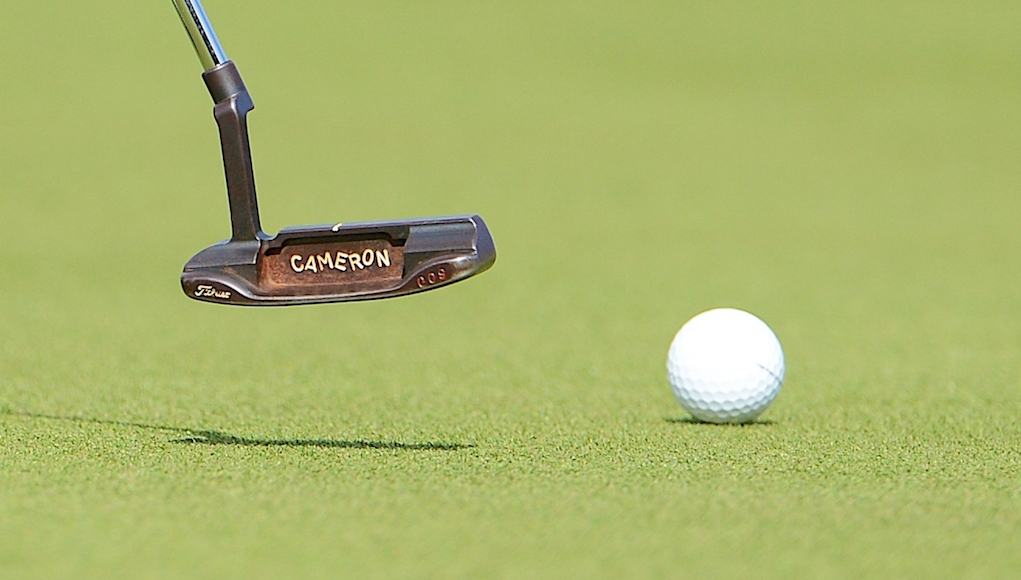Instruction
The Ultimate Putting Program (Part 4): Green Reading

If you know one thing about green reading, it should be this: The golf ball abides by the laws of gravity and when in motion it will roll towards the low point of any slope.
A lot of golfers use mental images such as “picturing the break as how water would run off a green” to help them read their putts. They also follow adages such as “the putt will break away from nearby mountains,” or “the putt will break toward bodies of water.” These teachings are usually helpful and true, and should be taken into consideration. But there are also subtler elements that golf course architects build into greens to offset the natural lay of the land.
A sure way of reading greens can be determined by the speed of the green, the degree of the slope, the position that the ball sits on the slope, the length of the putt and sometimes the grain of the grass. The faster the green, the more break a golfer will need to play, as there is little friction to stop the ball from breaking. Steeper slopes will obviously produce more break.
The position on the slope can be referred to as a clock system where 6 o’clock is straight uphill and 12 o’clock is straight downhill. The closer the ball is to 10 o’clock and 2 o’clock, the more the ball will break. Now I am sure you’re probably wondering why the most break is not at 9 o’clock and 3 o’clock. It is because at 10 o’clock and 2 o’clock, the putt is downhill. That makes it faster, thus creating more break. The longer the putt, the more it will break as well.
Grain only affects the break on certain types of grasses such as Bermuda, and can be identified by the shine of the grass. When the grass seems shiny, it is down grain and will be faster than usual. When the grass is dull, it is into the grain and will be slower than usual.
The diagram above shows four quadrants that are true around any golf hole. Putts from quadrants A and B are downhill, whereas putts from quadrant C and D are uphill. Putts from quadrants A and C break left-to-right, whereas putts from quadrants B and D break right-to-left. The numbers on the diagram represent the clock system to identify a golfer’s position on the slope. The colored lines are the intended paths of the putt whereas the dotted lines represent the target lines or “Aimpoints.”
Let’s consider an example that I gave in one of my previous articles. A golfer in quadrant A who aims his putter left of the Aimpoint will need to compensate by rolling the ball at a slower speed to allow for more break and/or open the putter face at impact. The opposite is true for a right aimer, who will need to roll the ball at a faster speed for the ball to maintain its line and/or close the putter face at impact. This illustrates why aim, speed, and path are vital components to being a successful green reader. By eliminating variables and the need for compensations, a golfer will ultimately become more consistent.
After understanding the basic geometry to putting, green reading comes down to two methods: spot-putting and arc-putting.
Spot-Putting
Golfers who are spot-putters identify an Aimpoint at which they will putt toward on a straight line, allowing gravity to send the ball towards the hole. I suggest choosing an Aimpoint that is equal distance from the hole. It is important to note that the Aimpoint is not inline with the apex of the arc, but rather on a line tangent to the starting point. This ensures enough break for the ball to enter the hole on the “high-side,” i.e. “the pro side.” Far too many golfers don’t play enough break when reading greens.
After selecting an Aimpoint, golfers should become fully focused on its location and pay no attention to the hole. I believe this is a critical component in being a good spot putter. I for one have had great success with this method.
Spot-Putting Drill
In Part 3 of my series, I offered a drill to help golfers identify the target line by the use of a chalk line or a string suspended by knitting needles. This same drill can also be used on breaking putts. I suggest starting with the string method, as it is much easier to adjust to find the correct Aimpoint for a given putt. For a breaking putt, you will want to position the string on a line tangent to the intended arc. You will putt so that you roll the ball straight down the line, allowing gravity to roll the ball towards the hole.
Note: If interested, you may want to attend an Aimpoint class to learn more about this method of reading greens.
Arc-Putting
Golfers who are arc-putters identify with the intended arc of the putt and aim relative to that arc, but still keep a mental image of the hole. This may be viewed as a more “feel” based method of green reading, but can be equally as effective. It is important to start the ball high enough to allow for maximum break. I find visualizing the speed at which the ball will roll to be a good way to utilize this method.
Arc-Putting Drill
A great practice drill for arc-putters is to set up a pathway of tees from the ball to the hole on the intended arc (this may take some time, as you will need to adjust the tees to find the correct arc). You will then putt balls so that they roll through the pathway and into the hole.
This drill makes it easy to identify what variable within The Putting Triad is the root cause for a putt to ricochet off one of the tees. For that reason, I really like this drill. If you’re like me and find that your speed control is prohibiting you from consistently rolling the ball through the pathway, you may want to reread Part 2 of my series on how the weight of your putter affects speed control and make the necessary adjustments to your putter.
Depending on your natural way of visualizing the intended line of putt, you should benefit from selecting one of these methods of reading greens. Stay tuned for my next article on the importance of developing a pre-shot routine.
To Continue With The Ultimate Putting Program:
Instruction
The Wedge Guy: Beating the yips into submission

There may be no more painful affliction in golf than the “yips” – those uncontrollable and maddening little nervous twitches that prevent you from making a decent stroke on short putts. If you’ve never had them, consider yourself very fortunate (or possibly just very young). But I can assure you that when your most treacherous and feared golf shot is not the 195 yard approach over water with a quartering headwind…not the extra tight fairway with water left and sand right…not the soft bunker shot to a downhill pin with water on the other side…No, when your most feared shot is the remaining 2- 4-foot putt after hitting a great approach, recovery or lag putt, it makes the game almost painful.
And I’ve been fighting the yips (again) for a while now. It’s a recurring nightmare that has haunted me most of my adult life. I even had the yips when I was in my 20s, but I’ve beat them into submission off and on most of my adult life. But just recently, that nasty virus came to life once again. My lag putting has been very good, but when I get over one of those “you should make this” length putts, the entire nervous system seems to go haywire. I make great practice strokes, and then the most pitiful short-stroke or jab at the ball you can imagine. Sheesh.
But I’m a traditionalist, and do not look toward the long putter, belly putter, cross-hand, claw or other variation as the solution. My approach is to beat those damn yips into submission some other way. Here’s what I’m doing that is working pretty well, and I offer it to all of you who might have a similar affliction on the greens.
When you are over a short putt, forget the practice strokes…you want your natural eye-hand coordination to be unhindered by mechanics. Address your putt and take a good look at the hole, and back to the putter to ensure good alignment. Lighten your right hand grip on the putter and make sure that only the fingertips are in contact with the grip, to prevent you from getting to tight.
Then, take a long, long look at the hole to fill your entire mind and senses with the target. When you bring your head/eyes back to the ball, try to make a smooth, immediate move right into your backstroke — not even a second pause — and then let your hands and putter track right back together right back to where you were looking — the HOLE! Seeing the putter make contact with the ball, preferably even the forward edge of the ball – the side near the hole.
For me, this is working, but I am asking all of you to chime in with your own “home remedies” for the most aggravating and senseless of all golf maladies. It never hurts to have more to fall back on!
Instruction
Looking for a good golf instructor? Use this checklist

Over the last couple of decades, golf has become much more science-based. We measure swing speed, smash factor, angle of attack, strokes gained, and many other metrics that can really help golfers improve. But I often wonder if the advancement of golf’s “hard” sciences comes at the expense of the “soft” sciences.
Take, for example, golf instruction. Good golf instruction requires understanding swing mechanics and ball flight. But let’s take that as a given for PGA instructors. The other factors that make an instructor effective can be evaluated by social science, rather than launch monitors.
If you are a recreational golfer looking for a golf instructor, here are my top three points to consider.
1. Cultural mindset
What is “cultural mindset? To social scientists, it means whether a culture of genius or a culture of learning exists. In a golf instruction context, that may mean whether the teacher communicates a message that golf ability is something innate (you either have it or you don’t), or whether golf ability is something that can be learned. You want the latter!
It may sound obvious to suggest that you find a golf instructor who thinks you can improve, but my research suggests that it isn’t a given. In a large sample study of golf instructors, I found that when it came to recreational golfers, there was a wide range of belief systems. Some instructors strongly believed recreational golfers could improve through lessons. while others strongly believed they could not. And those beliefs manifested in the instructor’s feedback given to a student and the culture created for players.
2. Coping and self-modeling can beat role-modeling
Swing analysis technology is often preloaded with swings of PGA and LPGA Tour players. The swings of elite players are intended to be used for comparative purposes with golfers taking lessons. What social science tells us is that for novice and non-expert golfers, comparing swings to tour professionals can have the opposite effect of that intended. If you fit into the novice or non-expert category of golfer, you will learn more and be more motivated to change if you see yourself making a ‘better’ swing (self-modeling) or seeing your swing compared to a similar other (a coping model). Stay away from instructors who want to compare your swing with that of a tour player.
3. Learning theory basics
It is not a sexy selling point, but learning is a process, and that process is incremental – particularly for recreational adult players. Social science helps us understand this element of golf instruction. A good instructor will take learning slowly. He or she will give you just about enough information that challenges you, but is still manageable. The artful instructor will take time to decide what that one or two learning points are before jumping in to make full-scale swing changes. If the instructor moves too fast, you will probably leave the lesson with an arm’s length of swing thoughts and not really know which to focus on.
As an instructor, I develop a priority list of changes I want to make in a player’s technique. We then patiently and gradually work through that list. Beware of instructors who give you more than you can chew.
So if you are in the market for golf instruction, I encourage you to look beyond the X’s and O’s to find the right match!
Instruction
What Lottie Woad’s stunning debut win teaches every golfer

Most pros take months, even years, to win their first tournament. Lottie Woad needed exactly four days.
The 21-year-old from Surrey shot 21-under 267 at Dundonald Links to win the ISPS Handa Women’s Scottish Open by three shots — in her very first event as a professional. She’s only the third player in LPGA history to accomplish this feat, joining Rose Zhang (2023) and Beverly Hanson (1951).
But here’s what caught my attention as a coach: Woad didn’t win through miraculous putting or bombing 300-yard drives. She won through relentless precision and unshakeable composure. After watching her performance unfold, I’m convinced every golfer — from weekend warriors to scratch players — can steal pages from her playbook.
Precision Beats Power (And It’s Not Even Close)
Forget the driving contests. Woad proved that finding greens matters more than finding distance.
What Woad did:
• Hit it straight, hit it solid, give yourself chances
• Aimed for the fat parts of greens instead of chasing pins
• Let her putting do the talking after hitting safe targets
• As she said, “Everyone was chasing me today, and managed to maintain the lead and played really nicely down the stretch and hit a lot of good shots”
Why most golfers mess this up:
• They see a pin tucked behind a bunker and grab one more club to “go right at it”
• Distance becomes more important than accuracy
• They try to be heroic instead of smart
ACTION ITEM: For your next 10 rounds, aim for the center of every green regardless of pin position. Track your greens in regulation and watch your scores drop before your swing changes.
The Putter That Stayed Cool Under Fire
Woad started the final round two shots clear and immediately applied pressure with birdies at the 2nd and 3rd holes. When South Korea’s Hyo Joo Kim mounted a charge and reached 20-under with a birdie at the 14th, Woad didn’t panic.
How she responded to pressure:
• Fired back with consecutive birdies at the 13th and 14th
• Watched Kim stumble with back-to-back bogeys
• Capped it with her fifth birdie of the day at the par-5 18th
• Stayed patient when others pressed, pressed when others cracked
What amateurs do wrong:
• Get conservative when they should be aggressive
• Try to force magic when steady play would win
• Panic when someone else makes a move
ACTION ITEM: Practice your 3-6 foot putts for 15 minutes after every range session. Woad’s putting wasn’t spectacular—it was reliable. Make the putts you should make.
Course Management 101: Play Your Game, Not the Course’s Game
Woad admitted she couldn’t see many scoreboards during the final round, but it didn’t matter. She stuck to her game plan regardless of what others were doing.
Her mental approach:
• Focused on her process, not the competition
• Drew on past pressure situations (Augusta National Women’s Amateur win)
• As she said, “That was the biggest tournament I played in at the time and was kind of my big win. So definitely felt the pressure of it more there, and I felt like all those experiences helped me with this”
Her physical execution:
• 270-yard drives (nothing flashy)
• Methodical iron play
• Steady putting
• Everything effective, nothing spectacular
ACTION ITEM: Create a yardage book for your home course. Know your distances to every pin, every hazard, every landing area. Stick to your plan no matter what your playing partners are doing.
Mental Toughness Isn’t Born, It’s Built
The most impressive part of Woad’s win? She genuinely didn’t expect it: “I definitely wasn’t expecting to win my first event as a pro, but I knew I was playing well, and I was hoping to contend.”
Her winning mindset:
• Didn’t put winning pressure on herself
• Focused on playing well and contending
• Made winning a byproduct of a good process
• Built confidence through recent experiences:
- Won the Women’s Irish Open as an amateur
- Missed a playoff by one shot at the Evian Championship
- Each experience prepared her for the next
What this means for you:
• Stop trying to shoot career rounds every time you tee up
• Focus on executing your pre-shot routine
• Commit to every shot
• Stay present in the moment
ACTION ITEM: Before each round, set process goals instead of score goals. Example: “I will take three practice swings before every shot” or “I will pick a specific target for every shot.” Let your score be the result, not the focus.
The Real Lesson
Woad collected $300,000 for her first professional victory, but the real prize was proving that fundamentals still work at golf’s highest level. She didn’t reinvent the game — she simply executed the basics better than everyone else that week.
The fundamentals that won:
• Hit more fairways
• Find more greens
• Make the putts you should make
• Stay patient under pressure
That’s something every golfer can do, regardless of handicap. Lottie Woad just showed us it’s still the winning formula.
FINAL ACTION ITEM: Pick one of the four action items above and commit to it for the next month. Master one fundamental before moving to the next. That’s how champions are built.
PGA Professional Brendon Elliott is an award-winning coach and golf writer. You can check out his writing work and learn more about him by visiting BEAGOLFER.golf and OneMoreRollGolf.com. Also, check out “The Starter” on RG.org each Monday.
Editor’s note: Brendon shares his nearly 30 years of experience in the game with GolfWRX readers through his ongoing tip series. He looks forward to providing valuable insights and advice to help golfers improve their game. Stay tuned for more Tips!





























Keith
Jun 20, 2014 at 4:36 pm
Does putting truly need to be this technical?
CJ Decker
Jul 20, 2015 at 3:05 am
NO !! http://www.readinggreens.net THE FALL LINE – AIMPOINT – allows for a TWO INCH margin of error in feeling the fall line. SECRETS OF THE FALL LINE – uses basic math to locate and prove the fall line. SPEED – AIMPOINT – speed is specific with AimPoint because of all the other calculations developed for slope, putting trajectory and high pointing the apex. Use the correct speed and AimPoint works. SECRETS OF THE FALL LINE – allows the individual player to use their own speed, thus, allowing for putting trajectories such as charging your putt or lagging your putt … either works. LOOK, THERE’S A LOT MORE, but to Keith, there are alternatives and Secrets of The Fall Line is one of them. As for the experts at GolfWRX, it’s my understanding that this site was developed to help all golfers, not just champion one strategy over another. There’s a reason Mark Sweeney followed me on Twitter and not the other way around.
Nick O'Hern
Mar 25, 2014 at 7:25 pm
I like the clock diagram, explains it well, cheers Henry
nik d
Jan 6, 2014 at 10:07 pm
I disregard any putting tips, especially for my home course. even the big dogs say that putting there is a gamble.. I was practicing putting one day, and the head pro asked what I was doing, I told him I was practicing, his response “practicing! on these greens!, you would have better odds rolling those putts on a vegas crapps table”
Henry Stetina
Dec 30, 2013 at 7:24 pm
6 O’clock is the low point of the “clock.” 12 would be the high point.
R
Dec 30, 2013 at 5:34 pm
I think the diagram for the clock you’ve shown is wrong. For example, on the top left quadrant in the diagram (red line), to make that uphill putt (as you said, 6 is straight uphill), you’d have to aim above the hole as the slope will push it towards the right. Same way for the top left (turquoise line) you’d aim above the hole (given that 6 is straight uphill) in order to make it in.
A simple fix would be to call 12 straight uphill and 6 straight downhill 🙂
Henry Stetina
Dec 30, 2013 at 6:25 pm
I think you are confused. Red line is downhill left-to-right. Turquoise (top right) is downhill right-to-left.
R
Dec 30, 2013 at 7:15 pm
“The position on the slope can be referred to as a clock system where 6 o’clock is straight uphill and 12 o’clock is straight downhill”
Your image shows that the red line and turquoise line start towards 12 and end towards 6. that makes it an uphill putt.
Henry Stetina
Dec 30, 2013 at 7:25 pm
6 O’clock is the low point of the “clock.” 12 would be the high point.
R
Dec 30, 2013 at 7:29 pm
Never mind I see what you’re saying. Somewhat confusing because you say the position on the slope (slope being the subject in the sentence) is straight uphill at 6 and straight downhill at 12.
You should clarify such that it says something along the lines that THE PUTT is straight uphill at 6 and THE PUTT is straight downhill at 12. Makes it clearer that you’re referring the path the rolling putt takes.
Also, the lines referring to slope are somewhat misleading because you have the arrow at the bottom of the image (downward) pointed at slope. It would be clearer if you wrote instead of slope that 6 was the low point of the green and 12 was the high point of the green.
I understand your arrow shows that the slope is in that direction, but given this sentence…”The position on the slope can be referred to as a clock system where 6 o’clock is straight uphill and 12 o’clock is straight downhill”, it’s misleading in the sense that it describes the slope at 6 being uphill and the slope at 12 being downhill whereas you’re describing the putt.
Just a quick change of words and it’s much easier to understand.